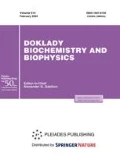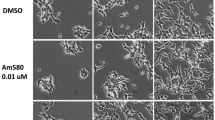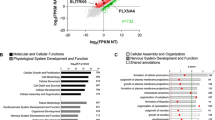Abstract
Neuroblastoma is one of the most common cancers in infants and is often multidrug-resistant. One of the methods of treating neuroblastomas is to create conditions for their differentiation. In this work, we performed a full-transcriptome analysis of gene expression in an undifferentiated and differentiated in vitro human neuroblastoma cell line IMR-32 and identified the signaling pathways and biological processes that undergo the greatest changes during differentiation. The results obtained show that a complex heterogeneous population of nerve cells is formed at different stages of differentiation. In the cell population of differentiating neuroblastoma, the expression of genes in which cortical neuronal progenitor cells are enriched increases; at the same time, there are cells expressing markers of early postmitotic neurons. Cells differentiate in several different directions according to the type of synaptic mediator. At the same time, the differentiation of IMR-32 cells is accompanied by an increase in the transcription of genes that suppress the differentiation of nerve cells, Sox2 and PROM1, the expression of which is normally suppressed during in vivo differentiation.


Similar content being viewed by others
REFERENCES
Dar, M.I., Jan, S., Reddy, G.L., et al., Differentiation of human neuroblastoma cell line IMR-32 by sildenafil and its newly discovered analogue IS00384, Cell Signal., 2020, vol. 65, p. 109425. https://doi.org/10.1016/j.cellsig.2019.109425
Louhivuori, L.M., Bart, G., Larsson, K.P., et al., Differentiation dependent expression of TRPA1 and TRPM8 channels in IMR-32 human neuroblastoma cells, J. Cell Physiol., 2009, vol. 221, pp. 67–74.
Gotti, C., Sher, E., Cabrini, D., et al., Cholinergic receptors, ion channels, neurotransmitter synthesis, and neurite outgrowth are independently regulated during the in vitro differentiation of a human neuroblastoma cell line, Differentiation, 1987, vol. 34, pp. 144–155.
Sher, E., Denis-Donini, S., Zanini, A., et al., Human neuroblastoma cells acquire regulated secretory properties and different sensitivity to Ca2+ and alpha-latrotoxin after exposure to differentiating agents, J. Cell Biol., 1989, vol. 108, pp. 2291–2300.
Kotapalli, S.S., Dasari, C., Duscharla, D., et al., All-trans-retinoic acid stimulates overexpression of tumor protein D52 (TPD52, isoform 3) and neuronal differentiation of IMR-32 cells, J. Cell Biochem., 2017, vol. 118, pp. 4358–4369.
Aygun, N. and Altungoz, O., MYCN is amplified during S phase, and c-myb is involved in controlling MYCN expression and amplification in MYCN-amplified neuroblastoma cell lines, Mol. Med. Rep., 2019, vol. 19, pp. 345–361.
Florio, M., Heide, M., Pinson, A., et al., Evolution and cell-type specificity of human-specific genes preferentially expressed in progenitors of fetal neocortex, Elife, 2018, vol. 7. e32332. https://doi.org/10.7554/eLife.32332
Abranches, E., Silva, M., Pradier, L., et al., Neural differentiation of embryonic stem cells in vitro: a road map to neurogenesis in the embryo, PLoS One, 2009, vol. 4, e6286. https://doi.org/10.1371/journal.pone.0006286
Takenobu, H., Shimozato, O., Nakamura, T., et al., CD133 suppresses neuroblastoma cell differentiation via signal pathway modification, Oncogene, 2011, vol. 30, pp. 97–105.
Yao, P.L., Chen, L., Dobrzanski, T.P., et al., Peroxisome proliferator-activated receptor-β/δ inhibits human neuroblastoma cell tumorigenesis by inducing p53- and SOX2-mediated cell differentiation, Mol. Carcinog., 2017, vol. 56, pp. 1472–1483.
Mishra, R. and Kaur, G., Tinospora cordifolia induces differentiation and senescence pathways in neuroblastoma cells, Mol. Neurobiol., 2015, vol. 52, pp. 719–733.
Mathuram, T.L., Ravikumar, V., Reece, L.M., et al., Tideglusib induces apoptosis in human neuroblastoma IMR32 cells, provoking sub-G0/G1 accumulation and ROS generation, Environ. Toxicol. Pharmacol., 2016, vol. 46, pp. 194–205.
Funding
This work was supported by the Russian Foundation for Basic Research (project no. 18-04-01306) and the Russian Science Foundation (project no. 19-14-00365).
Author information
Authors and Affiliations
Corresponding author
Ethics declarations
The authors declare that they have no conflict of interest. This article does not contain any studies involving animals or human participants performed by any of the authors.
Additional information
Translated by M. Batrukova
Rights and permissions
About this article
Cite this article
Stepchenko, A.G., Portseva, T.N., Ilyin, Y.V. et al. Differentiation of IMR32 Neuroblastoma Is Accompanied by a Global Change in the Transcriptome. Dokl Biochem Biophys 497, 90–94 (2021). https://doi.org/10.1134/S1607672921020149
Received:
Revised:
Accepted:
Published:
Issue Date:
DOI: https://doi.org/10.1134/S1607672921020149




